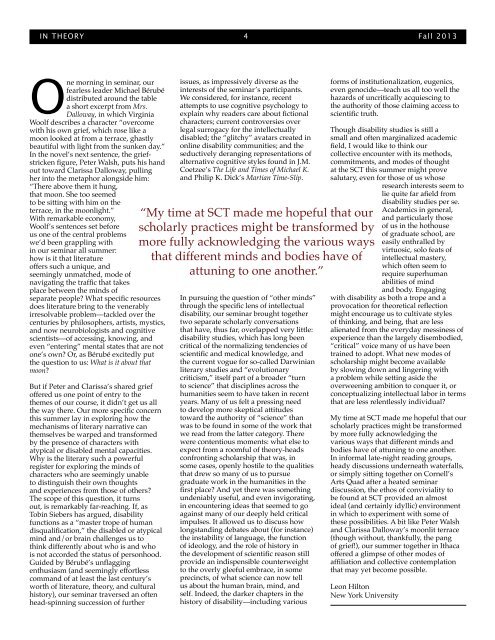to read our newsletter. - The School of Criticism and Theory - Cornell ...
to read our newsletter. - The School of Criticism and Theory - Cornell ...
to read our newsletter. - The School of Criticism and Theory - Cornell ...
Create successful ePaper yourself
Turn your PDF publications into a flip-book with our unique Google optimized e-Paper software.
IN THeory 4 Fall 2013One morning in seminar, <strong>our</strong>fearless leader Michael Bérubédistributed around the tablea short excerpt from Mrs.Dalloway, in which VirginiaWoolf describes a character “overcomewith his own grief, which rose like amoon looked at from a terrace, ghastlybeautiful with light from the sunken day.”In the novel’s next sentence, the griefstrickenfigure, Peter Walsh, puts his h<strong>and</strong>out <strong>to</strong>ward Clarissa Dalloway, pullingher in<strong>to</strong> the metaphor alongside him:“<strong>The</strong>re above them it hung,that moon. She <strong>to</strong>o seemed<strong>to</strong> be sitting with him on theterrace, in the moonlight.”With remarkable economy,Woolf’s sentences set beforeus one <strong>of</strong> the central problemswe’d been grappling within <strong>our</strong> seminar all summer:how is it that literature<strong>of</strong>fers such a unique, <strong>and</strong>seemingly unmatched, mode <strong>of</strong>navigating the traffic that takesplace between the minds <strong>of</strong>separate people? What specific res<strong>our</strong>cesdoes literature bring <strong>to</strong> the venerablyirresolvable problem—tackled over thecenturies by philosophers, artists, mystics,<strong>and</strong> now neurobiologists <strong>and</strong> cognitivescientists—<strong>of</strong> accessing, knowing, <strong>and</strong>even “entering” mental states that are no<strong>to</strong>ne’s own? Or, as Bérubé excitedly putthe question <strong>to</strong> us: What is it about thatmoon?But if Peter <strong>and</strong> Clarissa’s shared grief<strong>of</strong>fered us one point <strong>of</strong> entry <strong>to</strong> thethemes <strong>of</strong> <strong>our</strong> c<strong>our</strong>se, it didn’t get us allthe way there. Our more specific concernthis summer lay in exploring how themechanisms <strong>of</strong> literary narrative canthemselves be warped <strong>and</strong> transformedby the presence <strong>of</strong> characters withatypical or disabled mental capacities.Why is the literary such a powerfulregister for exploring the minds <strong>of</strong>characters who are seemingly unable<strong>to</strong> distinguish their own thoughts<strong>and</strong> experiences from those <strong>of</strong> others?<strong>The</strong> scope <strong>of</strong> this question, it turnsout, is remarkably far-reaching. If, asTobin Siebers has argued, disabilityfunctions as a “master trope <strong>of</strong> hum<strong>and</strong>isqualification,” the disabled or atypicalmind <strong>and</strong>/or brain challenges us <strong>to</strong>think differently about who is <strong>and</strong> whois not accorded the status <strong>of</strong> personhood.Guided by Bérubé’s unflaggingenthusiasm (<strong>and</strong> seemingly effortlesscomm<strong>and</strong> <strong>of</strong> at least the last century’sworth <strong>of</strong> literature, theory, <strong>and</strong> culturalhis<strong>to</strong>ry), <strong>our</strong> seminar traversed an <strong>of</strong>tenhead-spinning succession <strong>of</strong> furtherissues, as impressively diverse as theinterests <strong>of</strong> the seminar’s participants.We considered, for instance, recentattempts <strong>to</strong> use cognitive psychology <strong>to</strong>explain why <strong>read</strong>ers care about fictionalcharacters; current controversies overlegal surrogacy for the intellectuallydisabled; the “glitchy” avatars created inonline disability communities; <strong>and</strong> theseductively deranging representations <strong>of</strong>alternative cognitive styles found in J.M.Coetzee’s <strong>The</strong> Life <strong>and</strong> Times <strong>of</strong> Michael K.<strong>and</strong> Philip K. Dick’s Martian Time-Slip.“My time at SCT made me hopeful that <strong>our</strong>scholarly practices might be transformed bymore fully acknowledging the various waysthat different minds <strong>and</strong> bodies have <strong>of</strong>attuning <strong>to</strong> one another.”In pursuing the question <strong>of</strong> “other minds”through the specific lens <strong>of</strong> intellectualdisability, <strong>our</strong> seminar brought <strong>to</strong>gethertwo separate scholarly conversationsthat have, thus far, overlapped very little:disability studies, which has long beencritical <strong>of</strong> the normalizing tendencies <strong>of</strong>scientific <strong>and</strong> medical knowledge, <strong>and</strong>the current vogue for so-called Darwinianliterary studies <strong>and</strong> “evolutionarycriticism,” itself part <strong>of</strong> a broader “turn<strong>to</strong> science” that disciplines across thehumanities seem <strong>to</strong> have taken in recentyears. Many <strong>of</strong> us felt a pressing need<strong>to</strong> develop more skeptical attitudes<strong>to</strong>ward the authority <strong>of</strong> “science” thanwas <strong>to</strong> be found in some <strong>of</strong> the work thatwe <strong>read</strong> from the latter category. <strong>The</strong>rewere contentious moments: what else <strong>to</strong>expect from a roomful <strong>of</strong> theory-headsconfronting scholarship that was, insome cases, openly hostile <strong>to</strong> the qualitiesthat drew so many <strong>of</strong> us <strong>to</strong> pursuegraduate work in the humanities in thefirst place? And yet there was somethingundeniably useful, <strong>and</strong> even invigorating,in encountering ideas that seemed <strong>to</strong> goagainst many <strong>of</strong> <strong>our</strong> deeply held criticalimpulses. It allowed us <strong>to</strong> discuss howlongst<strong>and</strong>ing debates about (for instance)the instability <strong>of</strong> language, the function<strong>of</strong> ideology, <strong>and</strong> the role <strong>of</strong> his<strong>to</strong>ry inthe development <strong>of</strong> scientific reason stillprovide an indispensible counterweight<strong>to</strong> the overly gleeful embrace, in someprecincts, <strong>of</strong> what science can now tellus about the human brain, mind, <strong>and</strong>self. Indeed, the darker chapters in thehis<strong>to</strong>ry <strong>of</strong> disability—including variousforms <strong>of</strong> institutionalization, eugenics,even genocide—teach us all <strong>to</strong>o well thehazards <strong>of</strong> uncritically acquiescing <strong>to</strong>the authority <strong>of</strong> those claiming access <strong>to</strong>scientific truth.Though disability studies is still asmall <strong>and</strong> <strong>of</strong>ten marginalized academicfield, I would like <strong>to</strong> think <strong>our</strong>collective encounter with its methods,commitments, <strong>and</strong> modes <strong>of</strong> thoughtat the SCT this summer might provesalutary, even for those <strong>of</strong> us whoseresearch interests seem <strong>to</strong>lie quite far afield fromdisability studies per se.Academics in general,<strong>and</strong> particularly those<strong>of</strong> us in the hothouse<strong>of</strong> graduate school, areeasily enthralled byvirtuosic, solo feats <strong>of</strong>intellectual mastery,which <strong>of</strong>ten seem <strong>to</strong>require superhumanabilities <strong>of</strong> mind<strong>and</strong> body. Engagingwith disability as both a trope <strong>and</strong> aprovocation for theoretical reflectionmight enc<strong>our</strong>age us <strong>to</strong> cultivate styles<strong>of</strong> thinking, <strong>and</strong> being, that are lessalienated from the everyday messiness <strong>of</strong>experience than the largely disembodied,“critical” voice many <strong>of</strong> us have beentrained <strong>to</strong> adopt. What new modes <strong>of</strong>scholarship might become availableby slowing down <strong>and</strong> lingering witha problem while setting aside theoverweening ambition <strong>to</strong> conquer it, orconceptualizing intellectual labor in termsthat are less relentlessly individual?My time at SCT made me hopeful that <strong>our</strong>scholarly practices might be transformedby more fully acknowledging thevarious ways that different minds <strong>and</strong>bodies have <strong>of</strong> attuning <strong>to</strong> one another.In informal late-night <strong>read</strong>ing groups,heady discussions underneath waterfalls,or simply sitting <strong>to</strong>gether on <strong>Cornell</strong>’sArts Quad after a heated seminardiscussion, the ethos <strong>of</strong> conviviality <strong>to</strong>be found at SCT provided an almostideal (<strong>and</strong> certainly idyllic) environmentin which <strong>to</strong> experiment with some <strong>of</strong>these possibilities. A bit like Peter Walsh<strong>and</strong> Clarissa Dalloway’s moonlit terrace(though without, thankfully, the pang<strong>of</strong> grief!), <strong>our</strong> summer <strong>to</strong>gether in Ithaca<strong>of</strong>fered a glimpse <strong>of</strong> other modes <strong>of</strong>affiliation <strong>and</strong> collective contemplationthat may yet become possible.Leon Hil<strong>to</strong>nNew York University


